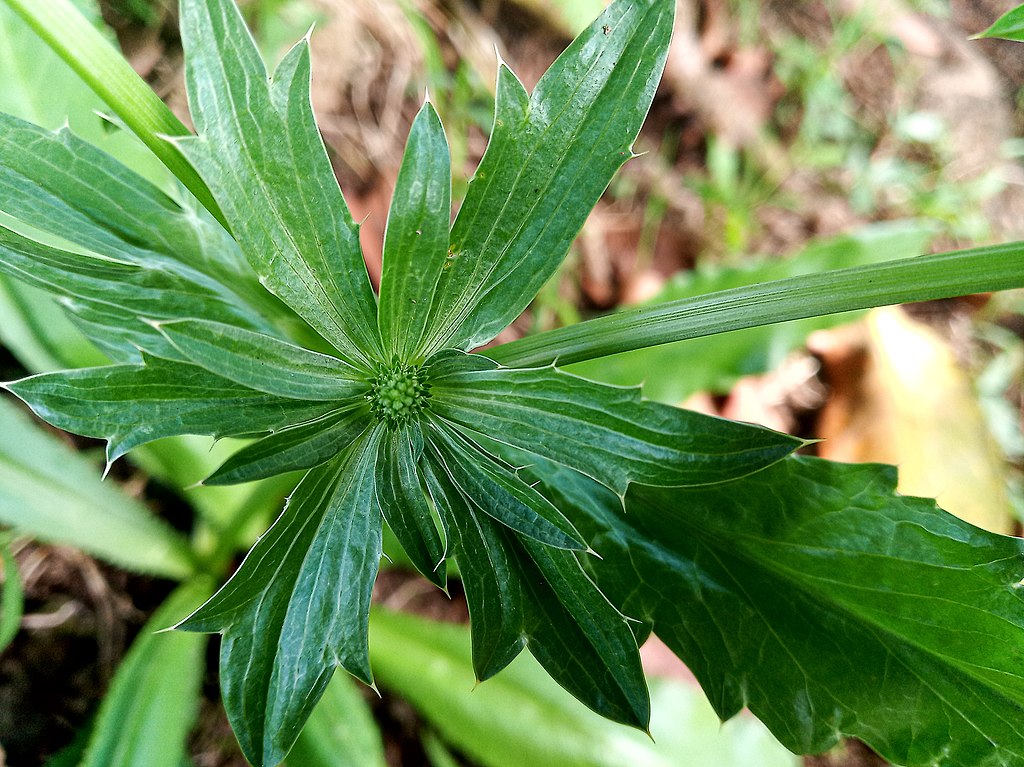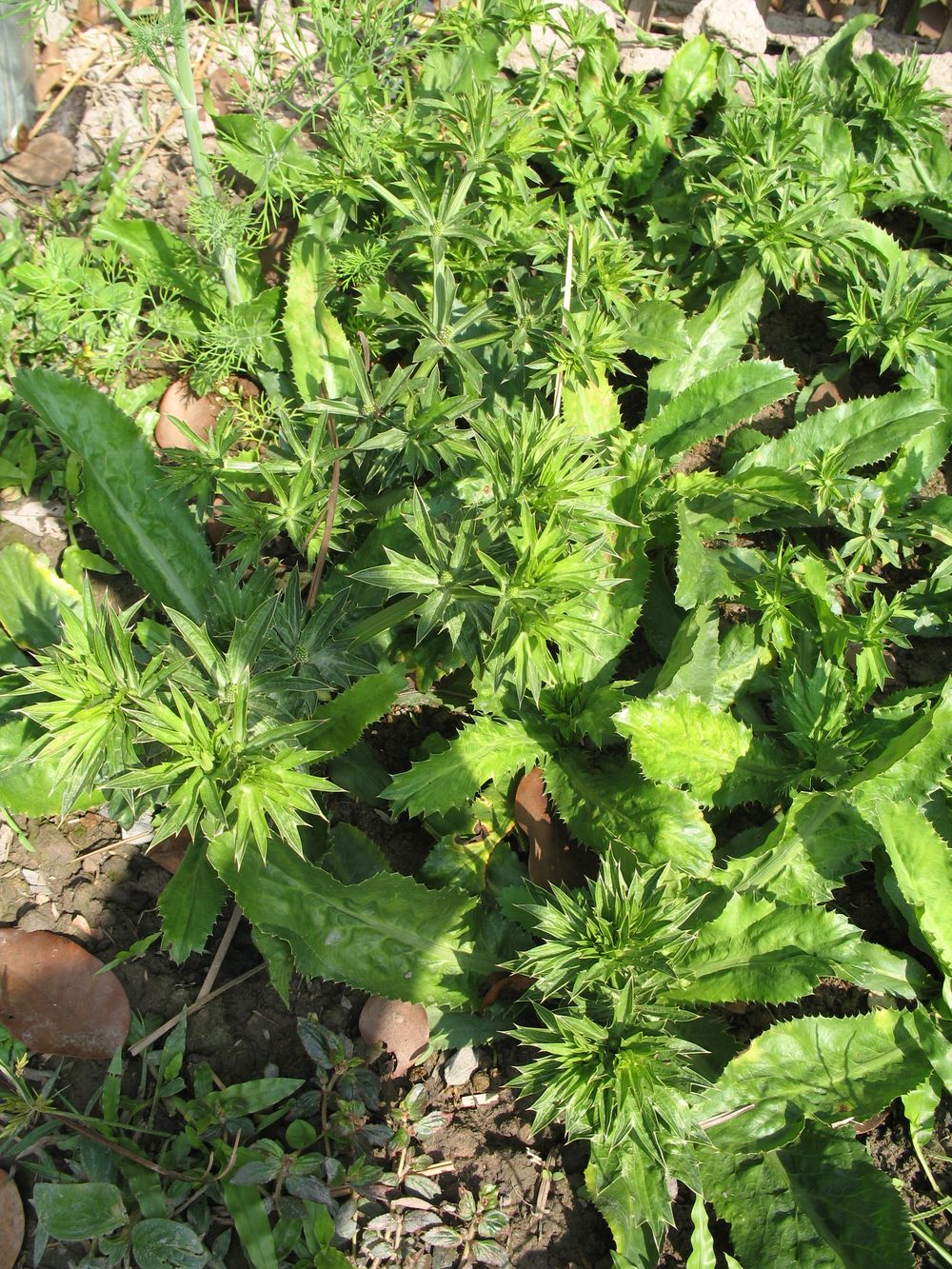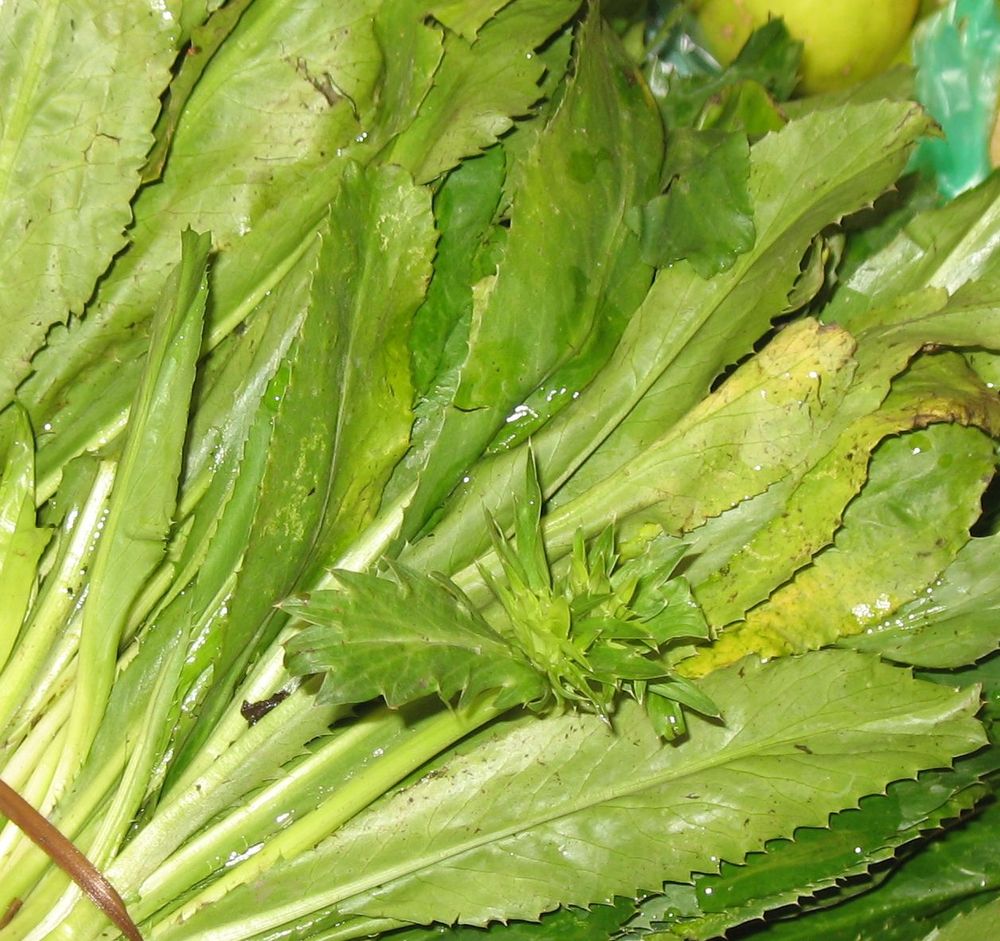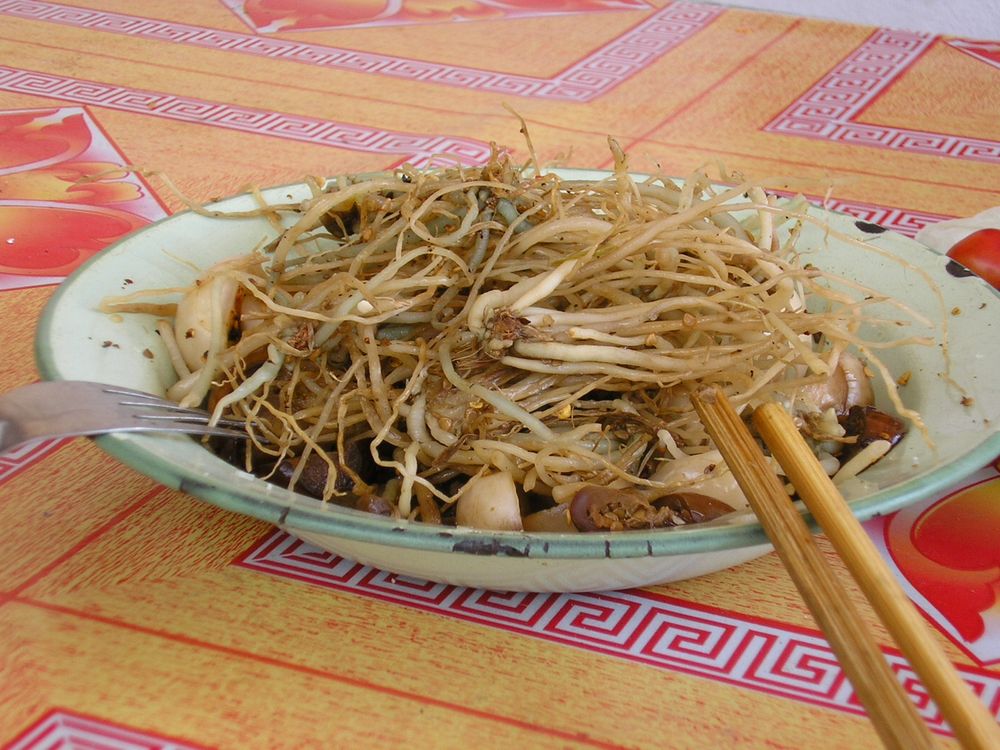Blessed thistle is one of the condiments that the Lao people call “hom“, meaning “that smells good”, along with, among others, mint (phak hom) and coriander (phak hom pom).
This tropical plant from Central America resembles a small thistle, hence its name in the French West Indies, to which is added “blessed”, as it is considered an important medicinal plant there. The flower bristling with green prickles appears in the middle of a rosette of long, serrated leaves that stay low to the ground. It is these leaves and the roots that are used as a condiment and/or medicine.
The taste of the leaves is very strong, even unpleasant, some say it is similar to that of coriander (see the English name), it would be rather close to that of radish or horseradish, with a pungent and bitter touch at the same time. It is also said in the West Indies that it is an “iron herb” because it would have the taste of iron. If you want to see for yourself, it is best to go to Vietnamese restaurants, especially those that sell soup, because after finely chopping these leaves, they are sprinkled on steaming bowls.
Among the Lao people, these leaves can be eaten raw with lap, but on the vegetable platters served at the table, phak hom phé is much less frequent than the other “sweet smelling leaves”. On the other hand, it is quite often used in various soups to give an extra spicy note. In the region of Phong Saly, a salad of small eggplants (tam mak keua) is prepared with the blanched roots of phak hom phé
While in the West Indies people take teas of blessed thistle leaves to fight the flu and give them energy, in Laos, traditional medicine prescribes a decoction of the root of the same plant to stimulate the appetite and promote digestion.
Finally, in Thailand, studies are underway to evaluate the active molecules of various traditional medicinal plants, including Eryngium foetidum.
Le Chardon béni fait partie des condiments que les Lao nomment « hom », c’est-à-dire « qui sent bon », avec, entre autres, la menthe (phak hom) et la coriandre (phak hom pom).
Cette plante tropicale originaire d’Amérique centrale ressemble à un petit chardon d’où son nom aux Antilles françaises, auquel on ajoute « béni », car elle est considérée là-bas comme une plante médicinale importante. La fleur hérissée de piquants verts apparaît au milieu d’une rosace de feuilles longues, dentelées, qui restent au ras du sol. Ce sont ces feuilles et les racines qui sont utilisées comme condiment et/ou comme médicament.
Le goût des feuilles est très fort, voir désagréable, certains le rapprochent de celui de la coriandre (voir le nom anglais), il serait plutôt voisin de celui du radis ou du raifort, avec une touche piquante et amère à la fois. On dit aussi aux Antilles que c’est une « herbe à fer » car elle aurait le goût du fer. Si vous voulez vous faire une idée par vous-même il faut aller de préférence dans les restaurants vietnamiens et plus particulièrement ceux qui vendent de la soupe car après avoir haché finement ces feuilles on en parsème les bols fumants.
Chez les Lao, on peut manger ces feuilles crues avec le lap mais, sur les plateaux de légumes servis à table, le phak hom phé est beaucoup moins fréquent que les autres « feuilles qui sentent bon ». En revanche on en met assez souvent dans les différentes soupes pour donner une note épicée supplémentaire. Dans la région de Phong Saly on prépare une salade de petites aubergines (tam mak keua) dans laquelle on met les racines blanchies de phak hom phé
Alors qu’aux Antilles on prend des thés de feuilles de Chardon béni pour combattre la grippe et donner du tonus, au Laos, la médecine traditionnelle prescrit une décoction de racine de la même plante pour stimuler l’appétit et favoriser la digestion.
Signalons enfin qu’en Thaïlande des études sont en cours pour évaluer les molécules actives de différentes plantes médicinales traditionnelles, dont Eryngium foetidum.




Blessed thistle is one of the condiments that the Lao people call “hom“, meaning “that smells good”, along with, among others, mint (phak hom) and coriander (phak hom pom).
This tropical plant from Central America resembles a small thistle, hence its name in the French West Indies, to which is added “blessed”, as it is considered an important medicinal plant there. The flower bristling with green prickles appears in the middle of a rosette of long, serrated leaves that stay low to the ground. It is these leaves and the roots that are used as a condiment and/or medicine.
The taste of the leaves is very strong, even unpleasant, some say it is similar to that of coriander (see the English name), it would be rather close to that of radish or horseradish, with a pungent and bitter touch at the same time. It is also said in the West Indies that it is an “iron herb” because it would have the taste of iron. If you want to see for yourself, it is best to go to Vietnamese restaurants, especially those that sell soup, because after finely chopping these leaves, they are sprinkled on steaming bowls.
Among the Lao people, these leaves can be eaten raw with lap, but on the vegetable platters served at the table, phak hom phé is much less frequent than the other “sweet smelling leaves”. On the other hand, it is quite often used in various soups to give an extra spicy note. In the region of Phong Saly, a salad of small eggplants (tam mak keua) is prepared with the blanched roots of phak hom phé
While in the West Indies people take teas of blessed thistle leaves to fight the flu and give them energy, in Laos, traditional medicine prescribes a decoction of the root of the same plant to stimulate the appetite and promote digestion.
Finally, in Thailand, studies are underway to evaluate the active molecules of various traditional medicinal plants, including Eryngium foetidum.
Le Chardon béni fait partie des condiments que les Lao nomment « hom », c’est-à-dire « qui sent bon », avec, entre autres, la menthe (phak hom) et la coriandre (phak hom pom).
Cette plante tropicale originaire d’Amérique centrale ressemble à un petit chardon d’où son nom aux Antilles françaises, auquel on ajoute « béni », car elle est considérée là-bas comme une plante médicinale importante. La fleur hérissée de piquants verts apparaît au milieu d’une rosace de feuilles longues, dentelées, qui restent au ras du sol. Ce sont ces feuilles et les racines qui sont utilisées comme condiment et/ou comme médicament.
Le goût des feuilles est très fort, voir désagréable, certains le rapprochent de celui de la coriandre (voir le nom anglais), il serait plutôt voisin de celui du radis ou du raifort, avec une touche piquante et amère à la fois. On dit aussi aux Antilles que c’est une « herbe à fer » car elle aurait le goût du fer. Si vous voulez vous faire une idée par vous-même il faut aller de préférence dans les restaurants vietnamiens et plus particulièrement ceux qui vendent de la soupe car après avoir haché finement ces feuilles on en parsème les bols fumants.
Chez les Lao, on peut manger ces feuilles crues avec le lap mais, sur les plateaux de légumes servis à table, le phak hom phé est beaucoup moins fréquent que les autres « feuilles qui sentent bon ». En revanche on en met assez souvent dans les différentes soupes pour donner une note épicée supplémentaire. Dans la région de Phong Saly on prépare une salade de petites aubergines (tam mak keua) dans laquelle on met les racines blanchies de phak hom phé
Alors qu’aux Antilles on prend des thés de feuilles de Chardon béni pour combattre la grippe et donner du tonus, au Laos, la médecine traditionnelle prescrit une décoction de racine de la même plante pour stimuler l’appétit et favoriser la digestion.
Signalons enfin qu’en Thaïlande des études sont en cours pour évaluer les molécules actives de différentes plantes médicinales traditionnelles, dont Eryngium foetidum.








Blessed thistle is one of the condiments that the Lao people call “hom“, meaning “that smells good”, along with, among others, mint (phak hom) and coriander (phak hom pom).
This tropical plant from Central America resembles a small thistle, hence its name in the French West Indies, to which is added “blessed”, as it is considered an important medicinal plant there. The flower bristling with green prickles appears in the middle of a rosette of long, serrated leaves that stay low to the ground. It is these leaves and the roots that are used as a condiment and/or medicine.
The taste of the leaves is very strong, even unpleasant, some say it is similar to that of coriander (see the English name), it would be rather close to that of radish or horseradish, with a pungent and bitter touch at the same time. It is also said in the West Indies that it is an “iron herb” because it would have the taste of iron. If you want to see for yourself, it is best to go to Vietnamese restaurants, especially those that sell soup, because after finely chopping these leaves, they are sprinkled on steaming bowls.
Among the Lao people, these leaves can be eaten raw with lap, but on the vegetable platters served at the table, phak hom phé is much less frequent than the other “sweet smelling leaves”. On the other hand, it is quite often used in various soups to give an extra spicy note. In the region of Phong Saly, a salad of small eggplants (tam mak keua) is prepared with the blanched roots of phak hom phé
While in the West Indies people take teas of blessed thistle leaves to fight the flu and give them energy, in Laos, traditional medicine prescribes a decoction of the root of the same plant to stimulate the appetite and promote digestion.
Finally, in Thailand, studies are underway to evaluate the active molecules of various traditional medicinal plants, including Eryngium foetidum.
Le Chardon béni fait partie des condiments que les Lao nomment « hom », c’est-à-dire « qui sent bon », avec, entre autres, la menthe (phak hom) et la coriandre (phak hom pom).
Cette plante tropicale originaire d’Amérique centrale ressemble à un petit chardon d’où son nom aux Antilles françaises, auquel on ajoute « béni », car elle est considérée là-bas comme une plante médicinale importante. La fleur hérissée de piquants verts apparaît au milieu d’une rosace de feuilles longues, dentelées, qui restent au ras du sol. Ce sont ces feuilles et les racines qui sont utilisées comme condiment et/ou comme médicament.
Le goût des feuilles est très fort, voir désagréable, certains le rapprochent de celui de la coriandre (voir le nom anglais), il serait plutôt voisin de celui du radis ou du raifort, avec une touche piquante et amère à la fois. On dit aussi aux Antilles que c’est une « herbe à fer » car elle aurait le goût du fer. Si vous voulez vous faire une idée par vous-même il faut aller de préférence dans les restaurants vietnamiens et plus particulièrement ceux qui vendent de la soupe car après avoir haché finement ces feuilles on en parsème les bols fumants.
Chez les Lao, on peut manger ces feuilles crues avec le lap mais, sur les plateaux de légumes servis à table, le phak hom phé est beaucoup moins fréquent que les autres « feuilles qui sentent bon ». En revanche on en met assez souvent dans les différentes soupes pour donner une note épicée supplémentaire. Dans la région de Phong Saly on prépare une salade de petites aubergines (tam mak keua) dans laquelle on met les racines blanchies de phak hom phé
Alors qu’aux Antilles on prend des thés de feuilles de Chardon béni pour combattre la grippe et donner du tonus, au Laos, la médecine traditionnelle prescrit une décoction de racine de la même plante pour stimuler l’appétit et favoriser la digestion.
Signalons enfin qu’en Thaïlande des études sont en cours pour évaluer les molécules actives de différentes plantes médicinales traditionnelles, dont Eryngium foetidum.


